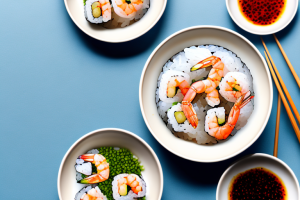How to cook sushi rice with tuna
9 min read
A bowl of sushi rice with tuna on top
Sushi is a popular Japanese dish that has managed to make a name for itself across the globe. The unique combination of vinegared rice and raw fish makes for a delectable treat that can be enjoyed as a meal, appetizer, or snack.If you’re a fan of sushi, or just want to try something new, then cooking sushi rice with tuna at home is a great place to start. In this article, we will take you through everything you need to know about making sushi rice with tuna, from the history of the dish to troubleshooting common mistakes.
The history of sushi rice and tuna
The origins of sushi can be traced back to the eighth century in Southeast Asia, where people would ferment fish with rice to preserve it for long periods. In Japan, this technique evolved into what we now know as sushi, where vinegared rice is combined with raw fish to create a dish that is both delicious and satisfying.
Tuna is one of the most popular fish used in sushi, prized for its meaty texture and rich flavor. Tuna was initially only consumed by the aristocracy in Japan, but as it became more widely available, it became a staple in sushi restaurants worldwide.
As sushi became more popular in Japan, different regions developed their own unique styles of sushi. For example, in Osaka, sushi is made with larger pieces of fish and rice, while in Tokyo, sushi is typically smaller and more delicate. These regional differences have contributed to the diverse range of sushi styles that we see today.
Today, sushi has become a global phenomenon, with sushi restaurants found in almost every major city around the world. In addition to traditional sushi, many chefs have also experimented with new and innovative sushi creations, incorporating ingredients like avocado, mango, and even foie gras into their dishes.
The best type of rice to use for sushi
If you want to make sushi rice with tuna, it’s essential to use the right type of rice. Japanese short-grain rice is the best choice for sushi, as it has a high starch content, which makes it sticky and easy to shape. The rice is cooked with vinegar, sugar, and salt to give it a sweet flavor and a glossy sheen.
To cook sushi rice, it’s important to rinse it thoroughly to remove excess starch and impurities. The rice is then soaked in water for about 30 minutes before being drained and cooked in a saucepan or rice cooker.
Aside from Japanese short-grain rice, there are other types of rice that can be used for sushi, such as medium-grain rice or even brown rice. However, these types of rice may not have the same sticky texture as Japanese short-grain rice, which can affect the overall quality of the sushi.
It’s also important to note that the quality of the rice can greatly affect the taste of the sushi. It’s recommended to use high-quality rice, such as Koshihikari rice, for the best results. This type of rice is known for its sweet flavor and soft texture, which makes it perfect for sushi.
How to prepare your tuna for sushi rice
The key to making delicious sushi rice with tuna is to use fresh, high-quality fish. You can buy sushi-grade tuna from a reputable fishmonger or use canned tuna if you prefer a cooked version.
If you’re using fresh tuna, it’s essential to remove any skin or bones before slicing it into thin strips. You can season the tuna with soy sauce, sesame oil, or any other flavors you prefer before combining it with the rice.
Another important factor to consider when preparing tuna for sushi rice is the temperature. It’s best to keep the tuna chilled until you’re ready to use it to prevent any bacterial growth. You can also place the sliced tuna on top of ice to keep it fresh and cool while you prepare the rice.
Lastly, if you’re using canned tuna, make sure to drain it thoroughly before adding it to the rice. You can also mix the canned tuna with mayonnaise or other ingredients to create a unique flavor profile for your sushi rolls.
Choosing the right seasoning for your sushi rice and tuna
Sushi rice is traditionally seasoned with a mixture of rice vinegar, sugar, and salt. The vinegar gives the rice a tangy flavor and helps to preserve it. You can adjust the seasoning to suit your taste, but the general rule is to use one part vinegar, one part sugar, and one-half part salt.
For the tuna, you can season it with soy sauce, wasabi, or any other spices you prefer. It’s important to taste the tuna before combining it with the rice to ensure it’s adequately seasoned.
Tips for perfectly cooked and seasoned sushi rice
Cooking sushi rice can be tricky, but with a few tips, you can get it right every time. Use a ratio of one cup of rice to one and a half cups of water, and bring the water to a boil before adding the rice. Once the rice is cooked, let it cool for a few minutes before seasoning it with vinegar, sugar, and salt.
Be careful not to overseason the rice, as this can overpower the delicate flavor of the tuna. Mix the rice and tuna gently to avoid squishing the rice grains, and make sure the tuna is evenly distributed throughout the rice.
The role of vinegar in making sushi rice with tuna
Vinegar is a critical ingredient in making sushi rice with tuna. It helps to bind the rice together, adds flavor, and prevents the growth of harmful bacteria. Rice vinegar is the most commonly used type of vinegar for sushi rice, but you can also use apple cider vinegar or any other mild vinegar.
The amount of vinegar used in sushi rice varies depending on personal preference, but it’s generally about three to four tablespoons per cup of cooked rice.
Step-by-step guide to cooking sushi rice with tuna at home
Now that we’ve covered all the basics, let’s take a look at how to make sushi rice with tuna at home. Follow these simple steps, and you’ll have delicious sushi in no time!
- Rinse one cup of sushi rice in a fine-mesh strainer until the water runs clear.
- Soak the rice in cold water for 30 minutes.
- Drain the rice and add one and a half cups of water to a saucepan.
- Bring the water to a boil and add the rice.
- Reduce the heat to low and cover the saucepan with a lid.
- Simmer for 15-20 minutes or until the water is absorbed.
- Remove the saucepan from the heat and let it sit covered for 10 minutes.
- In a small bowl, mix three tablespoons of rice vinegar, one tablespoon of sugar, and half a teaspoon of salt.
- Add the vinegar mixture to the rice and stir gently to combine.
- Add one can of drained and flaked tuna to the rice and mix gently to combine.
- Let the rice cool to room temperature before shaping it into sushi rolls or balls.
A beginner’s guide to making sushi rolls with cooked tuna and rice
Making sushi rolls can be intimidating, but with the right tools and techniques, it’s easy to master. Here’s a beginner’s guide to making sushi rolls with cooked tuna and rice:
- Place a sheet of nori seaweed on a bamboo sushi mat.
- Wet your hands and spread a thin layer of rice over the nori, leaving a one-inch border at the top.
- Add a thin layer of tuna or any other filling you prefer in a straight line across the rice.
- Roll the sushi tightly starting from the bottom edge, using the bamboo mat to help shape it.
- Use a sharp knife to slice the sushi into six to eight pieces.
How to make a spicy tuna roll with sushi rice at home
If you prefer a little heat with your sushi, then a spicy tuna roll is the perfect dish for you. Here’s how to make a spicy tuna roll with sushi rice at home:
- Mix one can of drained and flaked tuna with two tablespoons of mayonnaise, one tablespoon of Sriracha sauce, and half a teaspoon of sesame oil.
- Follow the steps outlined in the beginner’s guide to make a sushi roll with rice and tuna.
- Brush a mixture of soy sauce and Sriracha on top of the sushi rolls for an extra kick.
Creative ways to serve sushi rice and tuna as a meal or appetizer
Sushi rice with tuna doesn’t have to be limited to traditional sushi rolls. Here are some creative ways to serve sushi rice and tuna as a meal or appetizer:
- Maki bowl – Create a bowl by layering sushi rice, sliced tuna, avocado, cucumber, and sesame seeds.
- Sushi burgers – Make sushi rice patties and top them with cooked tuna, lettuce, tomato, and teriyaki sauce.
- Tuna and rice salad – Mix sushi rice, canned tuna, cherry tomatoes, red onion, and cilantro for a fresh and healthy salad.
- Tuna and rice tacos – Fill taco shells with sushi rice, cooked tuna, shredded lettuce, and a dollop of sour cream.
Pairing wine or sake with sushi rice and tuna dishes
Pairing wine or sake with sushi can be challenging, but there are a few rules to follow. Generally, light-bodied wines such as Pinot Grigio or Sauvignon Blanc complement sushi well, while sake is a traditional Japanese beverage that pairs well with all types of sushi.
If you want to try something new, why not mix up a sake cocktail? Try combining sake, lychee juice, and a dash of lime for a refreshing twist on a classic drink.
Variations of the classic sushi roll recipe with different types of fish
If tuna isn’t your favorite fish, don’t worry! Sushi rolls can be made with a variety of fillings, including salmon, shrimp, eel, and crab. The possibilities are endless, so don’t be afraid to experiment with different flavors and textures.
Frequently asked questions about cooking sushi rice with tuna
Here are some frequently asked questions about cooking sushi rice with tuna:
- Can I use regular rice instead of sushi rice?
- Can I use cooked tuna instead of raw tuna?
- How long should I let the rice cool before shaping it into sushi rolls?
Regular rice won’t work for sushi, as it doesn’t have the necessary starch content to make it sticky and easy to shape.
Yes, you can use cooked tuna in place of raw tuna if you prefer a different texture or flavor. Canned tuna is also a great option for a quick and easy meal.
The rice should be cooled to room temperature before shaping it into sushi rolls to ensure it’s pliable and easy to work with.
Troubleshooting common mistakes when cooking sushi rice with tuna
Even the best chefs make mistakes, but with a little know-how, you can fix any mishaps when making sushi rice with tuna. Here are some common mistakes and how to troubleshoot them:
- The rice is too dry or too wet.
- The rice is too sticky or clumpy.
- The tuna isn’t fresh.
If the rice is too dry, add a little more water or vinegar. If it’s too wet, spread the rice out on a baking sheet and let it dry for a few minutes before using it.
If the rice is too sticky, use a little less water or vinegar. If it’s too clumpy, make sure to rinse the rice thoroughly before cooking it.
Always use fresh, high-quality tuna when making sushi. If the tuna smells fishy or looks discolored, discard it and buy a fresh piece.
Now that you’re a sushi rice with tuna expert, try experimenting with different flavors and ingredients to create your own signature dish. The possibilities are endless!


